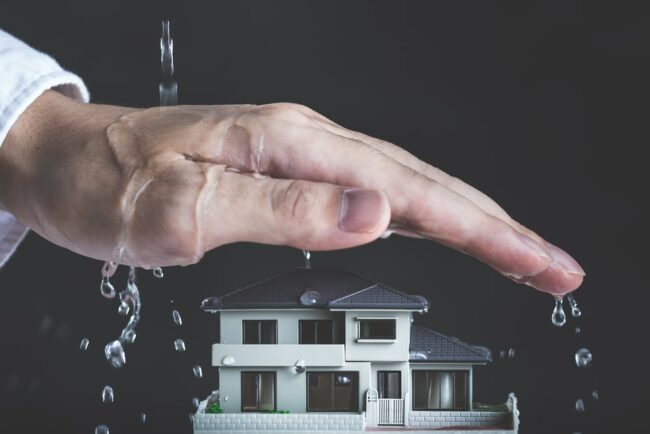When heavy rains fall, homeowners may ask, “Is water damage caused by rain covered by my homeowners insurance?” They may want to know. In some cases, the answer may be yes.
Q: As my house gets older, I’m concerned about the quality of the roof. Specifically, what happens if the roof leaks during a rainstorm? Does homeowner’s insurance cover water damage caused by rain?
A: The exterior walls of a home are designed to keep outside air in and to keep heat and cold out. As exterior components deteriorate or are damaged by storms, you may notice water leaks. Therefore, you may ask, ‘If rainwater enters my home, does my homeowner’s insurance cover damage caused by rain?
The answer depends on the exact manner in which rainwater enters your home. In the case of a sudden, unexpected event, such as wind damage, homeowners insurance may cover some water damage. However, if the water damage was caused by the homeowner’s negligence, such as failure to repair a leaking roof, homeowner’s insurance will not cover the damage.
Water damage caused by rain may be covered by homeowners insurance, depending on how the rain got into the home and what damage was done.
The best homeowner’s insurance policies usually cover a range of perils that can cause damage or destruction to a home. When it comes to water damage, homeowners insurance can cover water damage to the structure or the homeowner’s personal property, depending on the type and cause of the damage. How water enters a home is one of the most important factors in a homeowner’s ability to obtain a rainwater insurance claim. If a sudden event causes water to enter a home, a homeowner’s insurance may cover the damage.
For example, if a tree branch falls on the roof of a home and is damaged during a severe thunderstorm, rainwater may seep into the home. In this case, if the roof was in good condition before the storm, the homeowner’s insurance would likely cover the water damage caused by the event, less a deductible. This may vary among different types of homeowner’s insurance policies, as some cover more perils than others.
Generally, water damage caused by rain entering a home due to a covered peril such as wind damage may be covered by a homeowner’s insurance policy.
Storms that damage the exterior of a home are one of the most common ways that rainwater enters a building. Many homeowner’s insurance claims for roof leaks arise after a strong storm hits the area. Common types of storms that damage roofs and siding and allow rainwater to enter a home include
- Storms and tornadoes
- Hail (hail)
- Thunderstorms
- Roof leaks caused by sudden, heavy rain

Homeowners can usually file an insurance claim for water damage after one of these storms can allow rainwater to enter the home.
Renters insurance can also cover water damage if rain enters an apartment or rental home during or after a storm. However, unlike homeowner’s insurance, renters insurance does not cover the structure of the rental home – it is covered by the landlord’s insurance. Renters insurance rain coverage focuses on replacing or repairing the renter’s personal belongings, such as clothing and furniture, if they are damaged or destroyed by a covered event.
Homeowners insurance usually covers water damage caused by the weight of rain, snow or ice dams.
The weight of water in any form – rain, hail, ice or snow – is surprisingly large. When this weight is placed on the roof of a house, it can damage the roof. As a result, rainwater leaks down from above. In severe cases, the weight of water, ice and snow can even cause the roof to collapse.
Fortunately, homeowner’s insurance includes protection against roof damage caused by the weight of water. In addition, if a roof is damaged by ice or heavy snow, homeowner’s insurance will usually cover the cost of roof repairs if the roof was adequately repaired prior to the damage.

For example, if partially melted snow turns to ice on a homeowner’s roof and creates a dam that causes more water to accumulate on the roof, a hole may form in the roof. This hole may then allow ice, hail, snow, rain or other water to enter the home. The cost of repairing the damage may be covered by the homeowner’s insurance.
Mold caused by rain from a sudden disaster may also be covered by a homeowner’s insurance policy.
In addition to homeowner’s insurance covering roof leaks due to sudden or unexpected perils, homeowner’s insurance companies may also cover mold repairs to remove mold that has formed as a result of a leak. If rain or other water suddenly enters a home, homeowners should be aware of the risk of mold growth and watch for signs of mold so that the problem can be addressed quickly.
For example, a hailstorm damages the roof of a home and water begins to seep into the attic. The homeowner notices mold on the upstairs ceilings and, upon inspecting the attic, discovers that a large portion of the floor is covered with mold. Since rainwater infiltration is an insured event, the homeowner’s insurance may cover the cost of the best water damage restoration services and mold removal services.
Rainwater damage from vandalism is also usually covered by a homeowner’s insurance policy.
Vandalism and break-ins often cause damage to the exterior of a home. Broken windows and doors can bring rainwater to the property. This rainwater can cause water damage to walls, floors, furniture, etc. if the homeowner is out of town or does not immediately realize the damage. The good news is that homeowner’s insurance usually covers vandalism and may cover the cost of repairing water damage, as well as deductibles.
However, vandalism coverage is limited. Generally, the property must be occupied for the homeowner to obtain vandalism coverage. Homeowners are advised to read their policies carefully to see if there are any coverage limitations. For example, the policy may state that the insured property cannot be left vacant for more than 60 days. If an incident such as vandalism occurs and rainwater is allowed to enter the building, the insurance company may deny the claim.
However, if the water damage is caused by flooding from heavy rains, homeowner’s insurance will usually not cover it.
Flooding and inundation are usually excluded from homeowner’s insurance. If a rainstorm causes a riverbank to overflow and flood a neighborhood, homeowners insurance will not cover a homeowner who does not have flood insurance.
In addition, homeowners insurance companies are likely to classify water that seeps into a home after a heavy rain as flooding. For example, heavy rains may cause groundwater to seep into the basement of a home and cause flooding. A homeowner can make an insurance claim, but in most cases, water on the ground and entering the home is considered flooding and is more likely to go uncovered.
Homeowners may want to clarify with their insurance company the difference between flooding and water damage under their policy. This can give them a good idea of whether their homeowner’s policy covers certain types of water damage.
CLICK NEXT PAGE BELOW TO CONTINUE READING …










